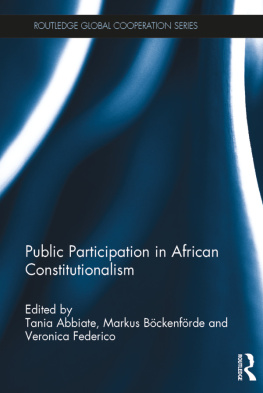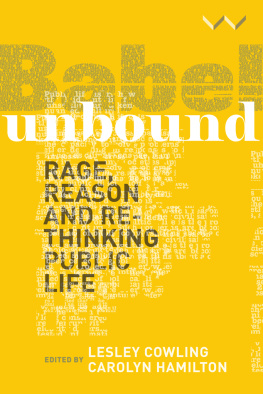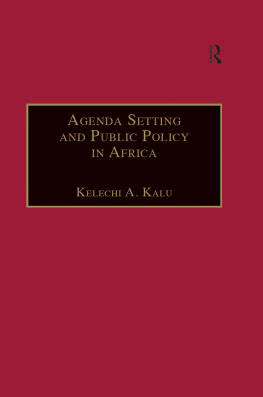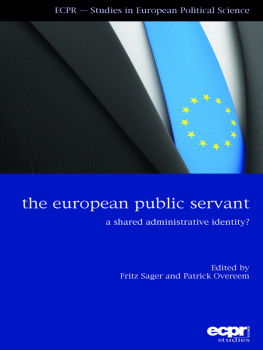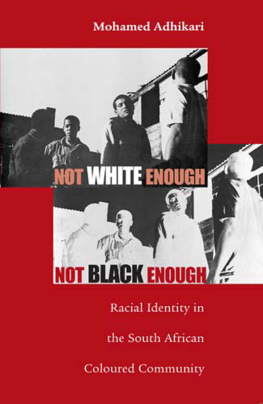Published in South Africa by:
Wits University Press
1 Jan Smuts Avenue
Johannesburg
www.witspress.co.za
Entire publication Wits University Press 2011
Compilation Xolela Mangcu 2011
Chapters Individual authors 2011
First published 2011
ISBN (print) 978-1-86814-532-4
ISBN (EPUB - IPG) 978-1-86814-820-2
ISBN (EPUB - ROW) 978-1-86814-821-9
ISBN (PDF) 978-1-86814-557-7
All rights reserved. No part of this publication may be reproduced, stored in a retrieval system, or transmitted in any form or by any means, electronic, mechanical, photocopying, recording or otherwise, without the written permission of the publisher, except in accordance with the provisions of the Copyright Act, Act 98 of 1978.
Cover design by The Library
Book design and layout by The Library
Printed and bound by Ultra Litho (Pty) Limited
PREFACE
XOLELA MANGCU
In 2006 my colleague Carolyn Hamilton invited me to be a fellow in the Constitution of Public Intellectual Life Project at Wits University. The aim of the fellowship was to deepen and broaden discussions around the role of the archive in South Africa. I took up this question in relation to the making of a new South African identity asking: why does it matter that nations should care for their archives, and that they should develop a sense of shared identity? And why should these processes take place in the public domain? How could nations possibly speak about a shared sense of identity in pluralistic societies where individuals and groups also have multiple identities? And how, as Hamilton asks in her essay in this volume, can such conversations be given relevance in public discussions of reconciliation and development in South Africa?
In order to problematise these questions I thought it would be useful to invite outside scholars to join local commentators in a series of public deliberations on the contestations of archive and identity that often characterise new nations. The outside scholars I invited are regarded as leading authorities on questions of national identity and archive in the world.
In my essay, which opens the discussion in this book, I describe as evidentiary genocide the denial of the role of the Black Consciousness Movement and the Pan Africanist movement in the narrative of democracy in South Africa. In fact, denial is only part of the story. Even more dangerous has been the representation of black consciousness as a nativist movement quite the furthest from what it was, and from Steve Bikos description of black identity in strictly political (as opposed to biological) terms. Aim Csaire once said that blackness is historical and there is nothing biological about it. The exclusion and then re-presentation of black consciousness from the public archive has had deleterious effects on our political culture, particularly in terms of how we think about identity, progress and development a point that Carolyn Hamilton also makes in her chapter, which closes this volume.
In his chapter, Ntongela Masilela seeks to redress what Hamilton calls the neglect and negation of the archive of black intellectual history. Masilela has put together the most comprehensive online archive on black intellectual history, giving truth to Edward Saids argument about how the Internet has altered the inert concept of the archive we have inherited from the past. Titled the New African Movement, the website brings to life the contributions of nineteenth and twentieth century black intellectuals such as Tiyo Soga, John Tengo Jabavu, WB Rubusana, Magema Fuze, SEK Mqhayi, WW Gqoba, Sol Plaatje, RV Selope Thema, HIE Dhlomo and Benedict Vilakazi. While Masilelas primary motivation is to redress the negation of the archive of black intellectual history, his website is also racially and ethnically quite eclectic. It also includes scholars, writers and political figures with varying political and intellectual outlooks from nineteenth century missionaries such as John William Colenso and Alexander Kerr to Mohandas Gandhi, Clement Martyn Doke, Fatima Meer, Alex La Guma, Peter Abrahams and many others. Masilelas essay is an example of what is possible when scattered materials are convened as an archive. In mapping the transmission lines of the circulation of ideas among the New Africans, Masilela uses his web archives to make a contribution to the reconfiguring of the archive. Later in this volume Carolyn Hamilton describes the archive as the circumscribed body of knowledge of the past that is historically determined as that which is available for us to draw on when thinking about the past. In his chapter, Masilela gives close attention to the formation of intellectual constellations and draws our attention to the processes by which the intellectuals of what became known as the New African Movement sought, as early as the mid-nineteenth century, to imagine a new African modernity. Their modernity incorporated the African past in ways very different from the intellectual texts of European modernity, effectively using the new newspapers of the time as the setting for public deliberation on African modernity. Masilelas essay in this volume emphasises a long tradition of problematisation, whether of the ideas of tradition and chieftaincy, the popular and the classical, or of modernity and collective democratic leadership. It is, in that sense, a much needed antidote to nativist essentialism.
The late Frederick van Zyl Slabbert takes up the theme of the use of the past to suit present-day ideological interests, and puts the accent on individual notions of identity. According to Slabbert, the past is being selectively drawn upon in South Africa today to establish Africanism in an exclusive sense as the new dominant ideology. Taking as his starting point Thabo Mbekis 1996 I am an African speech, Slabbert offers a critique of the concept of African-ness as a value-laden ideological concept of nationality, ethnicity and race. While Mbekis speech contained an inclusive vision of the African, the current political climate makes it clear that a coloured, Indian or white person is not generally seen as an African. Slabbert takes his cue from the so-called National Question outlined in the ANC journal Umrabulo No. 23 and put before the ANC National Congress in June 2005, which is about the liberation of Blacks in general and Africans in particular. To Slabbert, the racialisation of public policy through affirmative action and black economic empowerment programmes go against the non-racial idealism in Mbekis speech. In his view, the moment one moves away from a geographical definition of the African one enters a world of ideological agendas and value judgments. He asserts that he is African because he is from Africa, because he grew up and lives in South Africa and because he has a South African identity document. He concludes on an uncompromising note: by inventing the past to suit current ideological pursuits, it becomes more difficult to avoid repeating mistakes in dealing with the problems of the present. Slabberts essay thus prompts us to consider how an exclusionary discourse of Africanism can work to alienate significant sections of the population. Equally, Slabberts contribution draws our attention to the challenges that face white South Africans as they grapple with their African identity and in assuming their responsibilities as citizens who can enter spaces of public deliberation as individuals committed to the problematisation of identity.
Martin Bernals challenge is the critical excavation of the archive to back claims of human achievement. I have known Martin Bernal from my student days at Cornell University in the early to mid-1990s. Anyone interested in the role of Africa in the world would have been attuned to the heated debates that came in the wake of the publication of




